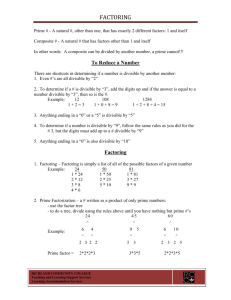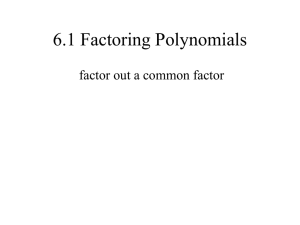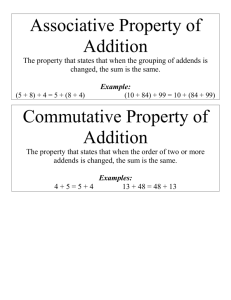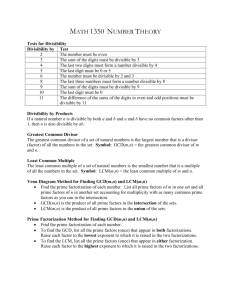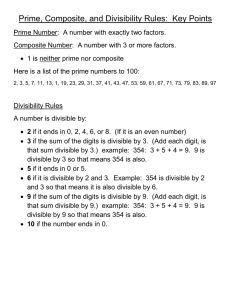Definition 1. A prime number is a natural number greater than 1
advertisement
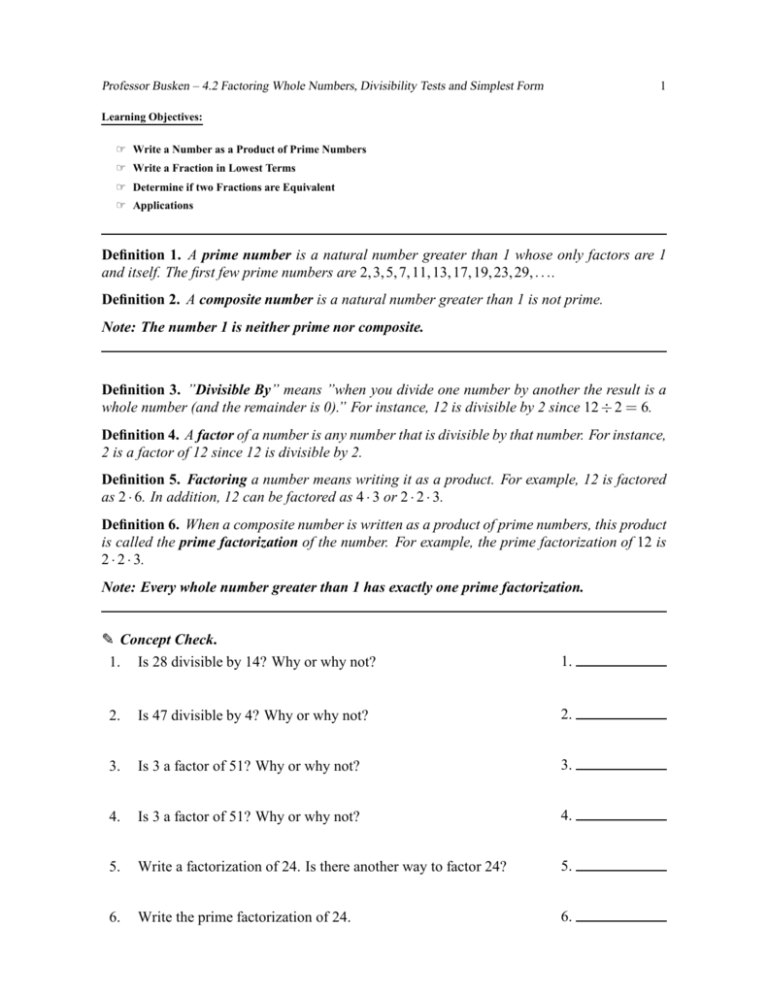
Professor Busken – 4.2 Factoring Whole Numbers, Divisibility Tests and Simplest Form 1 Learning Objectives: ☞ Write a Number as a Product of Prime Numbers ☞ Write a Fraction in Lowest Terms ☞ Determine if two Fractions are Equivalent ☞ Applications Definition 1. A prime number is a natural number greater than 1 whose only factors are 1 and itself. The first few prime numbers are 2, 3, 5, 7, 11, 13, 17, 19, 23, 29, . . .. Definition 2. A composite number is a natural number greater than 1 is not prime. Note: The number 1 is neither prime nor composite. Definition 3. ”Divisible By” means ”when you divide one number by another the result is a whole number (and the remainder is 0).” For instance, 12 is divisible by 2 since 12 ÷ 2 = 6. Definition 4. A factor of a number is any number that is divisible by that number. For instance, 2 is a factor of 12 since 12 is divisible by 2. Definition 5. Factoring a number means writing it as a product. For example, 12 is factored as 2 · 6. In addition, 12 can be factored as 4 · 3 or 2 · 2 · 3. Definition 6. When a composite number is written as a product of prime numbers, this product is called the prime factorization of the number. For example, the prime factorization of 12 is 2 · 2 · 3. Note: Every whole number greater than 1 has exactly one prime factorization. ✎ Concept Check. 1. Is 28 divisible by 14? Why or why not? 1. 2. Is 47 divisible by 4? Why or why not? 2. 3. Is 3 a factor of 51? Why or why not? 3. 4. Is 3 a factor of 51? Why or why not? 4. 5. Write a factorization of 24. Is there another way to factor 24? 5. 6. Write the prime factorization of 24. 6. Professor Busken – 4.2 Factoring Whole Numbers, Divisibility Tests and Simplest Form 2 7. Write the prime factorization of 42. 7. 8. Write the prime factorization of 60. 8. The Divisibility Rules A whole number is divisible by: • 2 if the last digit is 0,2,4,6, or 8. 132 is divisible by 2 since the last digit is a 2. • 3 if the sum of the digits is divisible by 3. 144 is divisible by 3 since 1 + 4 + 4 = 9 is divisible by 3. • 4 if its last two digits are divisible by 4. 1812 is divisible by 4. • 5 if the last digit is 0 or 5. 1475 is divisible by 5 since the last digit is a 5. • 6 if its divisible by 2 and 3. 9456 is divisible by 6. • 9 if the sum of its digits is divisible by 9. 5238 is divisible by 9 since 5 + 2 + 3 + 8 = 18 is divisible by 9. • 10 if the right-most digit in the number is a 0. 500 is divisible by 10, but 1012 is not. 9. Use the Divisibility Rules to write the prime factorization of 171. 9. 10. Use the Divisibility Rules to write the prime factorization of 245. 10. 11. Use the Divisibility Rules to write the prime factorization of 316. 11. Professor Busken – 4.2 Factoring Whole Numbers, Divisibility Tests and Simplest Form 3 Definition 7. To write a fraction in simplest form, or lowest terms, write the prime factorization of the numerator and the denominator and then divide both by all common factors. The process of writing a fraction in simplest form is called simplifying the fraction. Example: Write Solution: 3 in lowest terms. 12 (3 ÷ 3 ) 1 3 3÷3 1 3 = = = = = 12 2 · 2 · 3 2 · 2 · 3÷3 2 · 2 · (3 ÷ 3) 2 · 2 · 1 4 ✎ Write each fraction in lowest terms. 12. 16 24 12. 13. 6 39 13. Theorem 1. If a, b, c, and d are numbers and b and d are not 0, then a c a·c = · b·d b d Example: Use Theorem 1 to simplify Solution: 78 102 Professor Busken – 4.2 Factoring Whole Numbers, Divisibility Tests and Simplest Form Example: Simplify 4 18x 45 Solution: ✎ Write each in simplest form. 14. 15 35 14. 15. 40xy 15y 15. 16. 6 24 16. 17. 63 51 17. 18. 364x 924x 18. Professor Busken – 4.2 Factoring Whole Numbers, Divisibility Tests and Simplest Form 5 Theorem 2 (Equality of Fractions). Two proportions are equivalent if their cross products are equivalent. That is, c a = whenever a · d = b · c. b d For instance, to check if 2 10 = , 5 25 10 2 = 5 25 we test whether or not 5 · 10 = 25 · 2. If cross products are not equal, then the fractions are not equal. Example: 1 6 = since 12 · 1 = 2 · 6. 12 2 ✎ Determine if the fractions are equivalent. 6 2 and 19. 24 34 19. 20. 27 3 and 5 45 20. 21. 2 8 and 12 5 21. 22. There are 100 centimeters (cm) in 1 meter. What fraction of a meter is 20 centimeters? 22.

